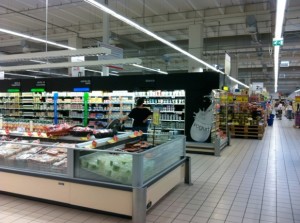 Almost a year ago I posted a blog explaining why I thought Carrefour might fail in China. This was based on a series of store visits to Carrefour Shanghai. Earlier this year a visit to another Carrefour store in Barcelona did relatively little to change my views. Readers of both posts will probably conclude I’m not much of a Carrefour fan, so imagine my surprise when I visited stores in Northern Italy that demonstrated that Carrefour can get it right – their in-store execution was spot-on!
Almost a year ago I posted a blog explaining why I thought Carrefour might fail in China. This was based on a series of store visits to Carrefour Shanghai. Earlier this year a visit to another Carrefour store in Barcelona did relatively little to change my views. Readers of both posts will probably conclude I’m not much of a Carrefour fan, so imagine my surprise when I visited stores in Northern Italy that demonstrated that Carrefour can get it right – their in-store execution was spot-on!
Back to basics
The stores I visited were both in Udine, a major regional center in the Northern province of Friuli-Venezia Giulia and they showed that when Carrefour gets back to the basics of effective retailing, they can really nail it in there outlets.
What I saw in the outlets was that Carrefour can:
- Deliver excellence in fresh foods
- Create great in-store environments
- Make their offering regionally compelling
- Deliver a coherent pricing strategy
Excellence in Fresh
I love shopping in Italy’s supermarkets, not such much because they are fabulous retailers but more because they really do have the best fresh food offers in the world. Italians demand the best in fresh produce so in any store you will find a great deli offer, fantastic fresh meat and fish and a fabulous choice of seasonal fresh veg. The Carrefour stores I saw were best in class in this whilst working to a globally recognizable footprint.
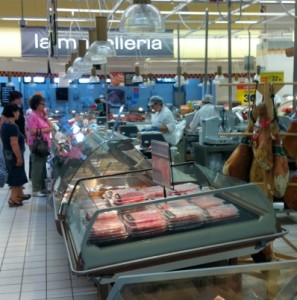 Another example of excellent in-store execution is in Carrefour’s “Macelleria” (Butchery), where shoppers queue to get their hand cut hams from a team of well-trained, efficient staff, in a well-laid out and fully-equipped deli station. And whilst the station itself does little to re-create the glamour of shopping in a family-owned specialist, it does a great job of delivering on Italians’ needs in terms of choice, freshness and appropriate pricing.
Another example of excellent in-store execution is in Carrefour’s “Macelleria” (Butchery), where shoppers queue to get their hand cut hams from a team of well-trained, efficient staff, in a well-laid out and fully-equipped deli station. And whilst the station itself does little to re-create the glamour of shopping in a family-owned specialist, it does a great job of delivering on Italians’ needs in terms of choice, freshness and appropriate pricing.
With many Italians are still eating as a family, especially at lunchtime, the right offer in fresh foods brings shoppers back to the store frequently whilst encouraging greater expenditure on affordable luxuries every trip.
Great in-store environments
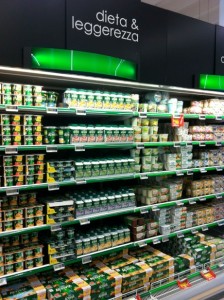 Yogurt is a pretty tough category to make interesting as often chilled units do little to convey a sense of theatre or to communicate shopper needs effectively. So this execution of the yogurt category got me excited. Not only is it clearly differentiated but also it does a great job of communicating the needs reflected in each segment cleanly and clearly.
Yogurt is a pretty tough category to make interesting as often chilled units do little to convey a sense of theatre or to communicate shopper needs effectively. So this execution of the yogurt category got me excited. Not only is it clearly differentiated but also it does a great job of communicating the needs reflected in each segment cleanly and clearly.
This clever execution no doubt has hugely positive impact not only on total sales, but also in driving traffic into higher value segments.
Regionally relevant offers
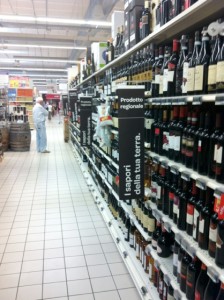
Shoppers all over the world seem to respond positively to the availably of not just generically available global brands but also to products that fit local tastes and preferences. This makes the supermarket experience just a little more personal, and offering a curated choice of regional product can differentiate a global retailer from its competitors, building local loyalty.
The people of Friuli are rightly proud of their excellent wines, which are produced in the western hills of the province. Carrefour’s wine fixture gives prominence to this – offering as much space to regional wines as is given to all other wines combined.
I particularly like the communication here. The sign says “The flavors of your land”.
Coherent pricing strategy – delivered
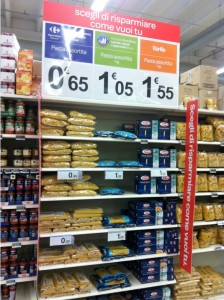 Too much of Carrefour’s focus in other countries is on promotions and whilst in these stores there were plenty of offers, one didn’t feel that the core message was ‘cheap’. What was interesting however was the clever use of pricing to encourage active comparison and to facilitate choice. These stores did this in two ways – the first very clearly, the second much more covertly.
Too much of Carrefour’s focus in other countries is on promotions and whilst in these stores there were plenty of offers, one didn’t feel that the core message was ‘cheap’. What was interesting however was the clever use of pricing to encourage active comparison and to facilitate choice. These stores did this in two ways – the first very clearly, the second much more covertly.
Carrefour makes no bones about offering a strong house brand but the way these stores communicated the value point of this brand was very clever. In key stable categories (Pasta, Biscuits, Oil), the different tiers of pricing were clearly on show.
In an approach that apes Tesco’s “good, better, best” strategy, known brands were compared on fixture with own label products. This is a far less cynical approach to own branding than that traditionally used by retailers – it offers shopper a clear choice without undermining the value of a known brand. The effect is a great profit-driving outcome as Carrefour can both capitalize on the higher cash profit of the known brand whilst also leveraging the higher percentage margin or its own brand – another example of excellent in-store execution.
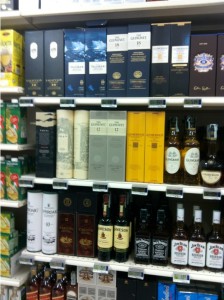 The second, more covert strategy is shown on the whiskey fixture.
The second, more covert strategy is shown on the whiskey fixture.
Here higher value product is given prominence in the hotspot – lower cost brands being sited either at the bottom or the top of the fixture. Placing high value items between shoulder and hip-height draws attention to the higher cost alternatives, driving trade up – another great outcome for brand and retailer alike.
Does excellent in-store execution mean a brighter future for Carrefour?
There’s a lot here that isn’t on show in many Carrefour outlets and it should be. Over dependence on promotions, a lack-luster fresh offer and poor merchandising have done a lot to undermine the retailer in recent years and performance has reflected this. If what the Italian business unit is doing is an indicator of the future, then better result should follow. All of the strategies shown here demonstrate a much clear focus on securing shopper loyalty and improving the profitability of the overall offer, which is to be applauded. The test for Carrefour is whether these in-store strategies can be efficiently applied in markets globally.
The manufacturer’s challenge:
What I’ve seen in Italy is a far cry from executions in perhaps more key markets like China, Spain and Taiwan and many manufacturers have struggled to gain traction in collaborating with Carrefour to enhance in-store execution and drive an agenda that extends beyond price and margin. Cases like these can be used to address this and effectively demonstrate what can be achieved within the group.
If you are struggling to get better traction with Carrefour and want specialist advice on how to do this in your market, feel free to contact me or my colleagues at engage.